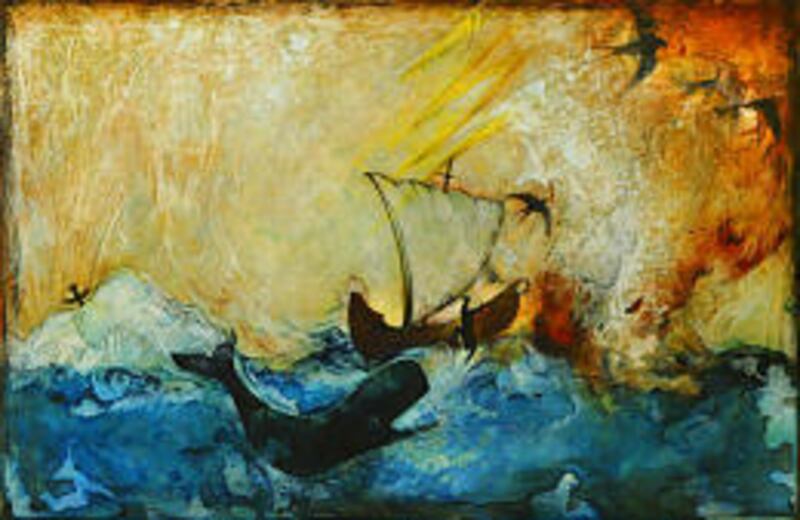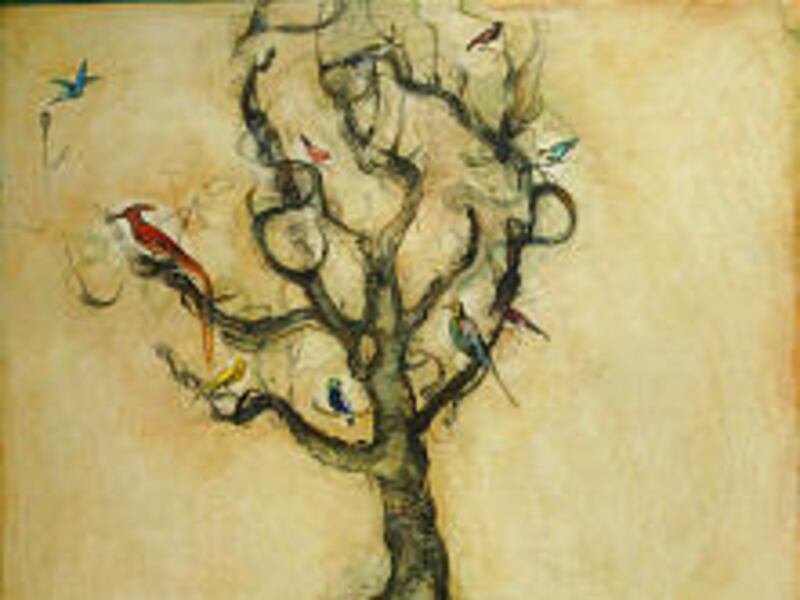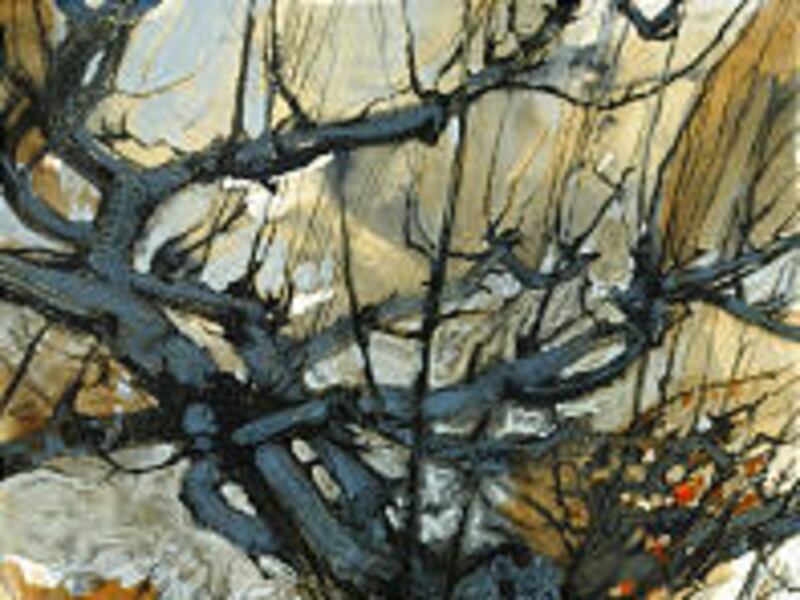In her exhibition of paintings and photographs, "Souvenirs," at the Finch Lane Gallery, Maureen O'Hara Ure has exposed her Gaelic roots — deep roots, tangled by memories of childhood, Catholicism, pedantry and the runes of modern art.
"Souvenirs" — a visual account of the artist's visit to Scotland and Ireland with her husband Lincoln Ure, an Episcopal priest — will challenge viewers' perceptions of the British Isles. Here there is no travelog, calendar art, images of pubs with ruddy-complexioned denizens or demure lassies and strapping lades gazing out over green, lush hills and crystal blue lakes.
Like a great Druid priestess, O'Hara Ure flays the Earth's surface, revealing primitive tendon and sinew, bone, gland and capillary. Viewers will experience surreal landscapes inhabited by exotic birds, a bear, a lamb, crucifixes, monks, and even animals from the illuminated manuscript of the late 8th century Book of Kells.
"You would be hard put, say, if you and I had been in the exact same location, to identify a specific silhouette of a specific mountain. I'm drawing from my memory and a thousand pictures," O'Hara Ure told the Deseret Morning News.
O'Hara Ure sketched while on the trip (some of her sketchbooks are in the show), but she admits that accuracy has no particular appeal for her. "My husband and I both have a fascination with the theological, giving theology equal weight with other pursuits." They're involved with something that, on one level, "doesn't make sense to a large part of the population."
Her religious disposition helps O'Hara Ure create her enigmatic and singular images. In the three-panel work "The Travelers (Part I)," "The Travelers (Part II)," and "The Travelers (Part III)" — all mixed media on panel, and each 24 by 93 inches — she employs Celtic curiosities from the Book of Kells, marrying them with collages of exotic birds.
O'Hara Ure's panel surfaces are so masterfully created that one can practically smell the ink and stretched goatskin of ancient, medieval manuscripts. Symbolic images pounce from the panel, titillating and confusing with minutiae, speaking to viewers in a language with which they are unfamiliar.
"The Family Tree (County Mayo)" (mixed media on panel, 29 1/2 by 25 3/4 inches) is a fairly representational painting of a barren tree teaming with exotic birds. At the base of the tree, roots scavenge in the earth, thick with the bleached skulls of ancestors. Though barren, the tree remains a place for the beautiful birds to rest.
O'Hara Ure has included 5 photographic dye prints in the exhibit; something she's never done in one of her shows. Each measures 44 by 40 inches.
"I feel like I should put all kinds of disclaimers on them: 'I am not a photographer,' 'this is not a photograph,' " she said. "But that's where the title for the show comes from, 'Souvenirs.' It's sort of almost diminishing the importance of something like that, sort of like saying, 'This is what I found here, this is what I brought back.' "
Her "Melrose Abby" literally looks like one of those old sepia-toned postcards. (O'Hara Ure said she did no computer manipulation of her images.)
Of her paintings the artist said, "They're all painted in a way that, if somebody called them drawings, that would be fine, too. They're painted with a lot of drawing mediums. That's my attitude towards them, that's what interests me most about them, this obsessive mark making on the surface."
"Souvenirs" is illuminating; it reveals an artist arguably at the peak of her form, giving viewers a chance to experience images unearthed by deep religious beliefs and tempered artistic experience.
In the gallery west of the one with O'Hara Ure's work, viewers will encounter a fresh new face: Lisa Hubbert. An MFA candidate at the University of Utah, Hubbert's paintings are gestural interpretations of orchards, up close and at a distance.
"There's an orchard nearby where I live in Highland that has been slated for housing development," Hubbert told the Deseret Morning News "This was the last chance for me to get in and really react with the orchard."
Hubbert isn't making any statements about the destruction of agricultural areas, "it's just my response to this particular place, of which I happen to be very fond."
The artist classifies herself as a Romantic Modernist. "It's not traditional landscapes, at least with this particular series."
In her artist statement Hubbert says she's interested in exploring the concept of perspective and proximity. "I got really fascinated," she said, "with the fact that if I pulled back to do a wider, almost panoramic view of the orchard, the paintings got really small." Yet when Hubbert focused on some branches or the trunk of a tree, the paintings "seemed to want to be bigger."
The smaller paintings in the show, such as "Equipoise," "Orchard in Red" and "Receding Storm" (all oil on paper on board and 12 by 12 inches) are more abstract, softer, simplified statements of form and shape and color. Even though they are small, they are still quite powerful.
Each of Hubbert's three "Proximity Series" paintings (oil on paper on board, 24 by 30 inches) are the works many viewers will find most exciting. The traffic of branches and trunks, leaves and sky, cohabit — albeit noisily — due to the artist's successful employment of positive and negative space, color, texture and balance.
"The paintings are just to be enjoyed," said Hubbert.
Viewers will.
Maureen O'Hara Ure is represented by Phillips Gallery, Salt Lake City. Lisa Hubbert is currently without representation.
E-mail: gag@desnews.com






